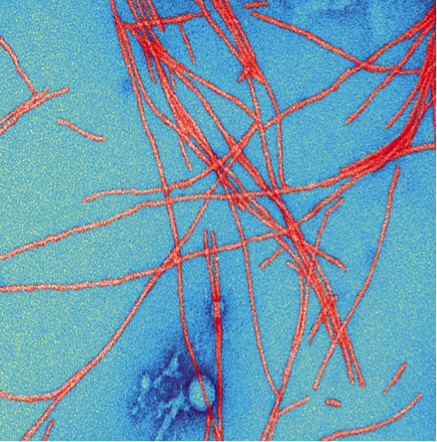Alzheimer’s Disease: Is It Communicable?

Jaunmuktane et al. Nature 525, 247–250 (2015)
Abnormally folded proteins are known as amyloid fibrils (red, top) and are strongly linked to Alzheimer’s disease. Amyloid-β protein (brown, bottom) has been found in the pituitary gland.
By Erin Stackowitz, Staff Writer
Alzheimer’s disease, a neurodegenerative disease that impairs cognitive functioning and ultimately leads to dementia, affects five million people annually and is the cause of eighty-three thousand deaths per year, according to The Center for Disease Control (CDC). The CDC estimates that by 2050, the number of people annually affected by Alzheimer’s will nearly triple to fourteen million.
Due to the disease’s tenacity and constant increase researchers are working tirelessly to find a solution to this pervasive disease. Recently, a controversial study published by Nature has suggested that the neurodegenerative disease might be transferred from one person to another through medical procedures and surgeries involving contaminated implants or injections.
John Collinge, a researcher a UCL Institute of Neurology, found evidence that abnormal brain proteins known as amyloid fibrils and prions that are associated with Alzheimer’s disease could have been transmitted to healthy patients by specific medical procedures that took place in the early 1980s. Collinge studied the autopsies of four patients that received hormonal injections from human cadavers and found that the preparations were contaminated with a mis-folded protein, a prion, that causes a rare and deadly condition called Creutzfeldt–Jakob disease (CJD), which subsequently lead to all of the patients dying in their late 40s.
Not only did the autopsies of these patients contain the prions, but they also contained white plaques (deposits of amyloid-b protein) unique to Alzheimer’s disease. These findings were remarkable because all of the patients died at a relatively young age and had no history of genetic predisposition to Alzheimer’s in their families, two conditions that are normally requirements of Alzheimer’s disease. The findings have prompted researchers to question whether or not the disease is now something that is transmissible and is a result of medical procedures inadvertently transferring amyloid-b protein.
To further support this theory, Collinge repeated his findings in animal studies but was not able to definitively prove whether or not transmission through a medical procedure did in fact cause the amyloid pathology in humans. Collinge also was not able to diagnose the patients with Alzheimer’s disease because the disease was not able to progress due to the fact that the subjects died from CJD.
Currently, there is no evidence that any medical procedure used today, including blood transfusions and routine surgeries, can transfer these amyloid proteins from one person to another, but research on the dangers of amyloid proteins are being examined and hopefully this will allow scientists to become one step closer in determining the cause of this debilitating and destructive disease.

